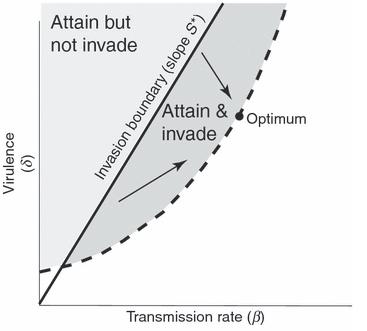Since TEH SWINE FLU!!!11!!! is a hot topic, I thought this post about how infections could evolve increased virulence after switching animal hosts was relevant. From the Murky Depths of the Mad Biologist's Archives: There's no reason to think that an epidemic influenza strain won't become more deadly....
Several people have argued that if an influenza pandemic were to occur, it will rapidly evolve to become less virulent--that is less deadly. A recent paper explains why this might be wrong.
Basically, the flaw with the 'optimistic' argument is that it is assumes that the virus will be optimally fit given its environment (lots of fat, juicy hosts to kill). As it starts to kill off its hosts, its virulence (ability to make dead people or 'deadliness') and transmission rate (ability to infect new hosts) will decrease to another optimal point where the virus will be able to maximize its intrinsic growth rate without killing off too many hosts. This shown below in the following cartoon (from the paper):

The Y-axis represents increasing dead people. The X-axis represents increasing transmission. The grey zone is the range of possible death rates and transmission rates (and I'm not up for going through the math), and the dotted line is the set of values that represents the optimal combination of virulence and transmission. The upper dot represents the optimal set of values when the host population size is S. As the virus kills people, and S decreases, the values move to a new, sustainable optimum shown by the lower dot.
So when the virus is at a fitness optimum, virulence and transmission will both decrease as the virus evolves in response to the changing host environment--that is, in response to killing its prey (an aside: the 'deadliness' of a virus in this model is the same as virulence).
Here's the fundamental problem: a new influenza strain probably won't be at the optimum in humans. It might be just dandy in chickens (or pigs), but, in humans, it will be good enough to spread (otherwise it wouldn't be a problem), but it won't be optimal. What this means is that increases or decreases in deadliness will be decoupled from fitness increases. In other words, a deadlier virus might be more fit, not less fit. That means there's no reason to assume that an influenza virus will automatically become less fit as shown by this cartoon (from the paper):

In this figure, the virus starts in the dark grey zone and moves towards the dot representing the optimum. If the virus starts at the top arrow, it will decrease in virulence (a good thing). But if it started at the lower arrow, it would actually become more virulent (a very bad thing). There's no way to predict what will happen. Either scenario is plausible. As the authors note:
H5N1 has not established itself in the human population, but the obvious fear is that it can do so and maintain its high mortality rate, at least during its first round of global spread. The invasion threshold perspective [the author's model] is thus especially relevant here. Ewald has used the public media to argue that the virulence of H5N1 will evolve to low levels, should it invade... this view has not been widely accepted...and the perspective of this paper is that, even if the H5N1 optimum in humans is low virulence, the epidemic could have devastating effects before it neared the viral optimum.
Oh dear.

Definitely more virulent. It's the nature of the beasties.
Even SARS' second wave was the troublesome one, which the media erroneously continues to compare to this very different SWINE flu.
It is the swine 'Spanish Flu' that the comparison should be made with.
The first wave (current) is similarly at the end of the flu season, and the resultant mild illness.
Let's see what the simmering mutations turn into this coming fall. THEN we'll see how optimistic we should be...